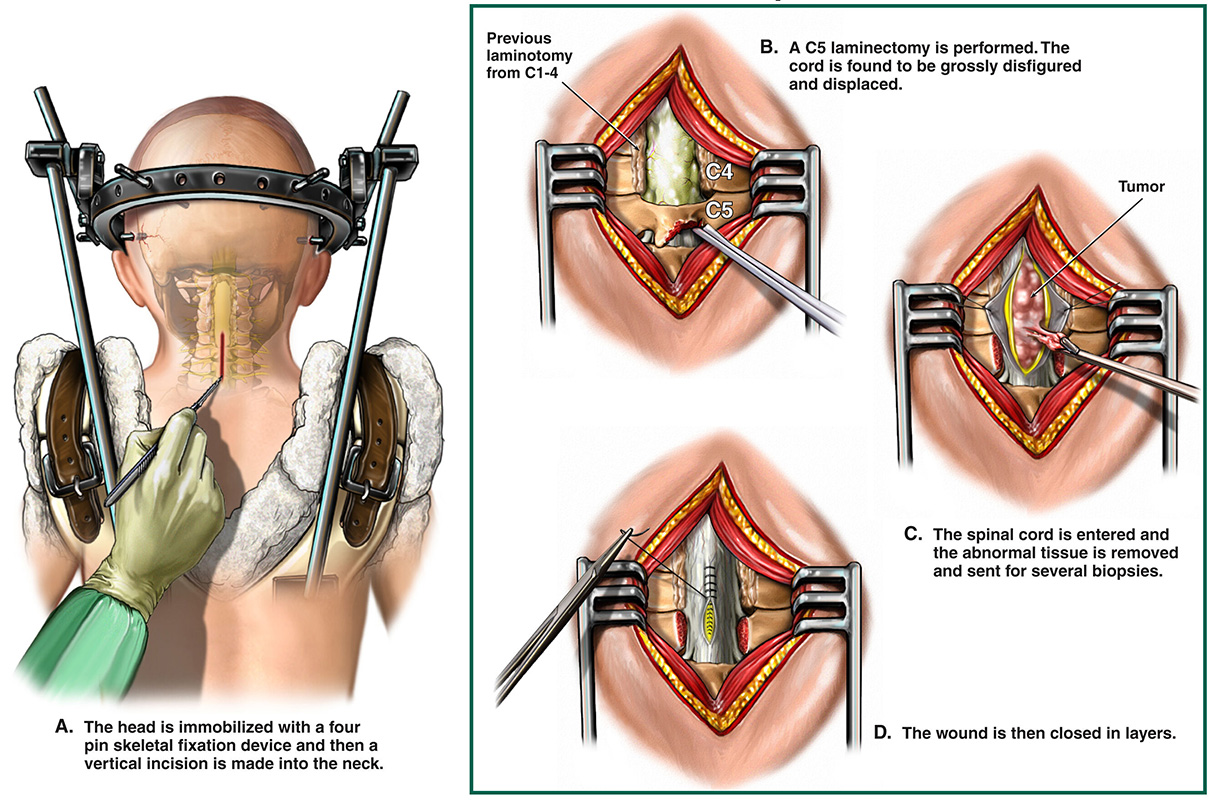Spinal Tumors Facts

- Lymphoma
- Myeloma
- Leukemia
Spinal cord tumors are a common childhood cancer
Brain and spinal tumors occur in both children and adults, although treatment for each group tends to be different. Although they are rare, brain and spinal cord tumors are the third most common type of childhood cancer.
How spinal cancer develops
Spinal cancer develops when abnormal cells in the spinal cord grow and divide in an uncontrolled way, interfering with normal functioning. There are more than 120 types of brain and central nervous system tumors and they are classified based on the origin of the cells and how aggressively they behave. In both children and adults, spinal tumors are most often benign.
Types of spinal cancer
- Meningeal tumors are most often benign. They sprout not from brain tissue itself but from thin, protective layers of the spinal cord called the meninges. Meningeal tumors tend to grow slowly and can become quite large before causing symptoms. Approximately one-third of brain tumors are meningiomas.
- Nerve sheath tumors, also called neurofibrosarcomas, grow in the cells that surround the peripheral nerves and are commonly caused by neurofibromatosis type 1.
- Ependymal tumors grow from ependymal cells, which are found in the ventricles. Since this type of brain tumor affects the ventricles, it can block the flow of cerebrospinal fluid and cause a condition called hydrocephalus.
- Astrocytic tumors develop from star-shaped brain cells called astrocytes. Astrocytomas tend to spread tentacle-like through tissue, making them difficult to remove surgically. Astrocytomas are rated based on how fast they grow — from high grade (fast-growing) to low grade (slow-growing).
- Oligodendrocytomas develop from cells called oligodendrocytes. They are more likely to grow slowly but can become more aggressive over time. Like astrocytomas, oligodendrocytomas tend to infiltrate normal tissue, making this type of tumor difficult to remove surgically.
- Mixed gliomas are tumors made up of two or more types of glioma cells, including astrocytomas, oligodendrocytomas and ependymomas. Mixed gliomas usually are treated based on the behavior of the most aggressive cells in the tumor.
- Medulloblastomas are malignant tumors, that occurs in infants and children, that start in the region at the base of the skull called the posterior fossa.
- Pineal parenchymal tumors are rare cancers that primarily occur in pediatric patients and originate in pineal cells, which are responsible for producing melatonin.
- Germ cell tumors begin in cells of the reproductive organs (sperm or egg) and are most common among teenage girls and young women.
- Craniopharyngiomas are benign tumors that develop near the pituitary gland, which is located near the base of the brain. These tumors types are most common in children but older adults may also develop them.
What increases your risk of spinal tumors?
Things that put you at higher risk for getting brain and spinal cancer are called risk factors. There are very few known causes of primary tumors, although certain genetic syndromes may increase risk including:
- Neurofibromatosis type 1 and 2 are nerve tumors of the skin, brain or spinal cord. Problems with the NF1 gene are much more likely to be implicated as a cause of brain tumors than changes to NF2.
- Tuberous sclerosis increases the risk of certain low-grade astrocytomas and benign tumors of the brain, heart, skin and other organs.
- Von Hippel-Lindau syndrome increases the risk of developing benign or malignant tumors in different parts of the brain and spinal cord; and other parts of the body including the pancreas, kidney, adrenal gland and inner ear.
- Li Fraumeni cancer syndrome is caused by changes to a gene called TP53 and is associated with a higher risk of developing gliomas and other types of cancer including sarcomas, leukemia and breast cancer.
- Other rare syndromes that increase the risk of brain and spinal tumors include Turcot syndrome and Nevoid basal cell carcinoma syndrome.
Infections such as Epstein-Barr virus and AIDS may increase risk of brain and spinal tumors, and receiving an organ transplant also increases the risk of certain central nervous system-related cancers.
Spinal tumor symptoms
Symptoms of adult spinal cord tumors are not the same in every person and depend on the stage, location and size of the tumor. Some common symptoms include:
- Back pain
- Nagging
- Unrelated to specific activities
- Worsens during rest
- Worsens over time
- Occurs at night
- Spinal deformity
- Neurological problems such as weakness or numbness in areas like the leg, knee or ankle
- Urinary, fecal incontinence
- Muscle spasms, twitches, weakness or function loss
- In later stages, weight loss, fever and fatigue
Other medical conditions share these symptoms. If you have any of these conditions, you may need further consultation to rule out spinal cancer.